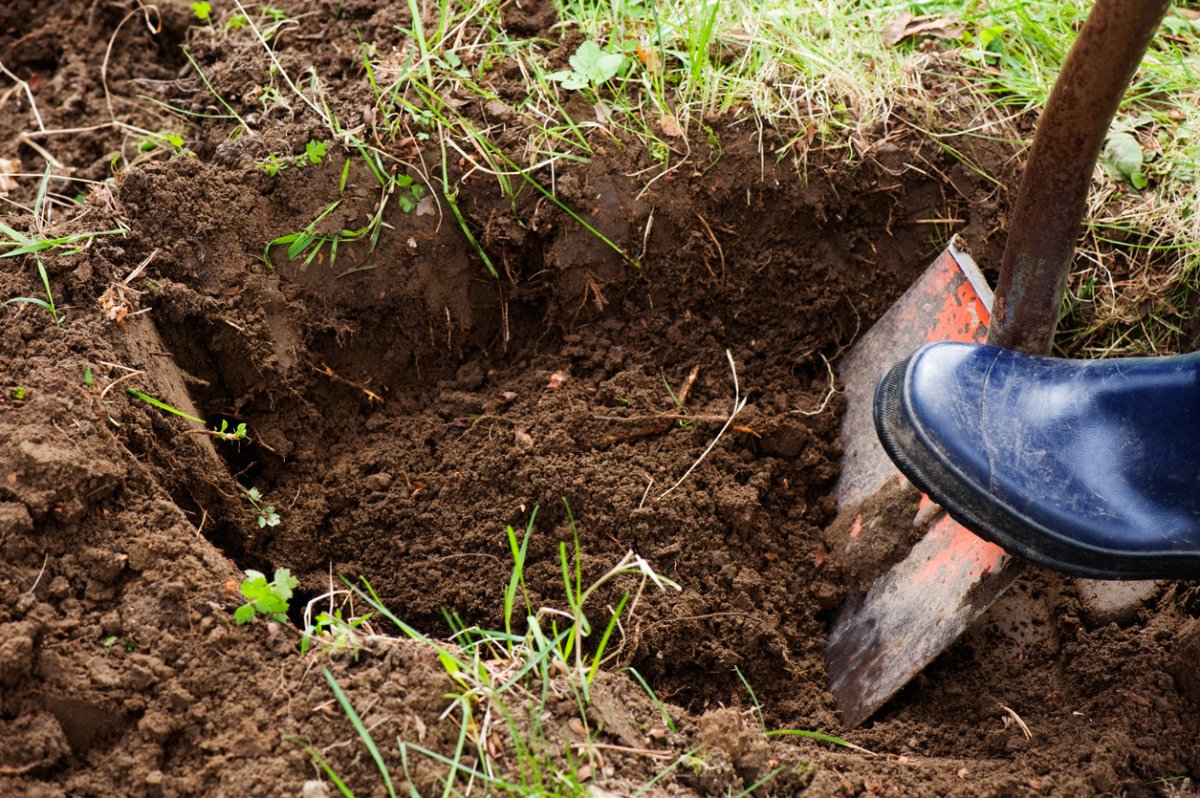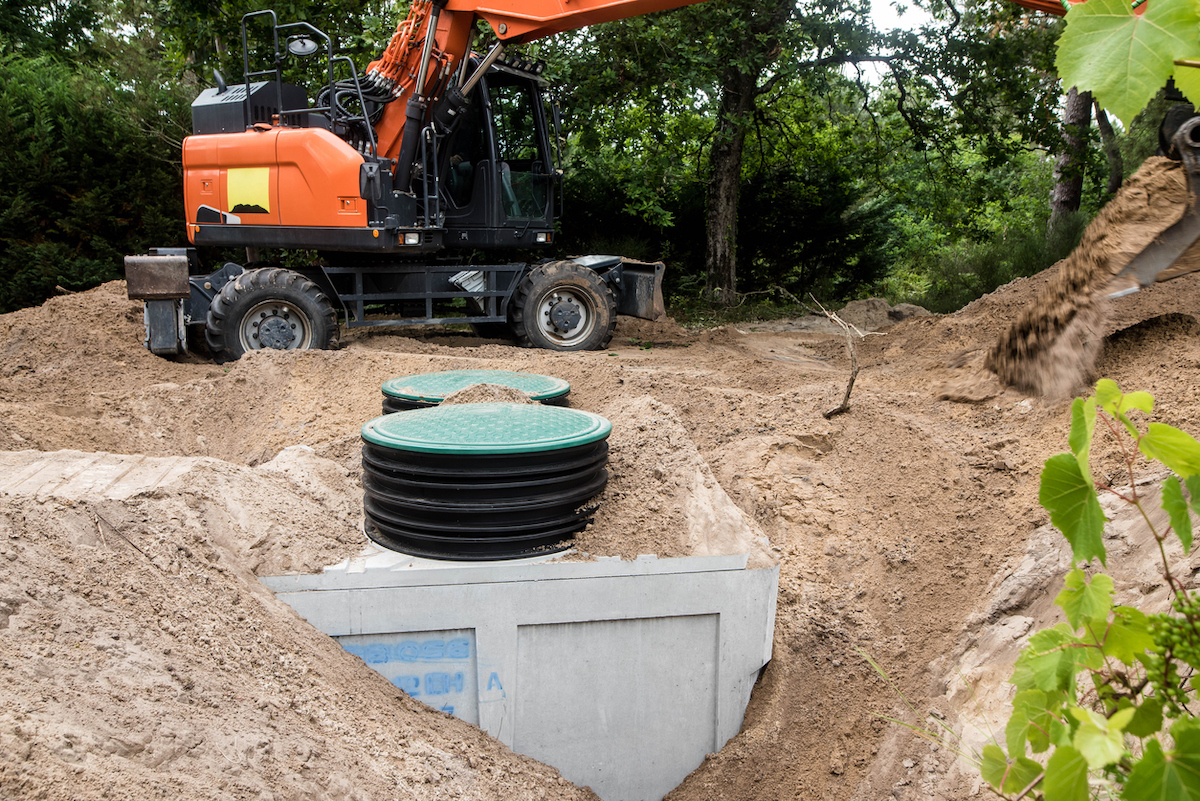

We may earn revenue from the products available on this page and participate in affiliate programs. Learn More ›
Q: I want to install a new septic system on my property, but before that can happen, the soil apparently needs to pass a perc test. What is a perc test and why do I need one before I can install a septic system?
A: Septic system installations, building planning, and agricultural use of the land are some of the most common reasons to get a perc test. Before hiring a crew to install a septic system, a perc test, or percolation test, is required to verify that the soil can drain and filter wastewater debris from a septic system.
So, what is a perc test? A perc test is a procedure performed by a trained professional to test the absorption rate of the soil. It’s conducted by digging several holes, adding about 2 inches of gravel, saturating the holes, then filling the holes with a predetermined amount of water. At this point, the technician takes regular measurements to determine how long it will take for the water to drain. Ideally, the percolation rate should fall between 10 and 60 minutes per inch of drop for a septic system leach field, though the test minimum and maximum range can vary depending on the location.
Percolation tests measure the moisture absorption rate of soil.
A soil percolation test is designed to measure the percolation rate, or moisture absorption rate, of the soil. Perc, meaning percolation, refers to the movement of water through the soil. This filtration process helps to treat wastewater from the septic system. After percolation, the water moves deeper into the ground until it reaches the water table. If the soil absorption rate is too fast, then wastewater could seep into the water table before it has been treated, polluting the groundwater for the area.
Percolation tests should be conducted at the end of summer or in early winter, when the soil is the driest. Perc test results are typically valid for up to 5 years, though this can vary between locations. A typical soil percolation test involves the technician digging a series of holes about 12 inches across and 2 to 3 feet deep. The technician adds 2 inches of gravel in the bottom of each hole, then saturates the holes with water to simulate a worst-case drainage scenario. When the holes are saturated, the technician adds a predetermined amount of water to the holes, then takes measurements at regular intervals to determine the absorption rate of the soil.
Septic system installation is the most common reason for a perc test.

Getting a perc test for septic system installation is usually the reason the average person would need this service. Before the septic system can be installed, the technicians need to verify that the selected area is suitable for drainage and filtration as the septic system leach field. When waste exits the home, it flows into the septic tank. Effluent from the top of the tank is released into the drainage field, where the wastewater is treated to remove contaminants as it percolates through the soil.
However, if the soil absorption rate is too fast, then the wastewater will drain through the soil and reach the groundwater before it can be filtered properly. This leads to the contamination of the groundwater, which can affect local wells, reservoirs, and nearby rivers or lakes. If the soil absorption rate is too slow, then the wastewater will take too long to filter down through the soil, resulting in a flooded field of sewage, water, and abhorrent odors. For this reason, it’s advised to get a perc test before buying land to ensure that the property can pass a land perc test for a septic system.
Perc tests aren’t cheap.
The average perc test cost ranges from about $750 to $1,850, though homeowners will typically pay about $1,300 for this service. Depending on the size of the leach field, local regulations, accessibility, and land use, some homeowners may end up paying as much as $3,000 for a perc test. However, a basic assessment of a hand-dug hole without relying on specialized equipment can be as affordable as $150 to $300.
Before hiring a company or an individual contractor to conduct a perc test, it’s recommended to research at least three reputable companies in the area to ensure that you get a fair price for the work. Alternatively, a DIYer who understands the process can conduct a perc test of the soil, though it’s important to note that these results are not considered official and cannot typically be used as reference or assurance during the sale of land or a home.
Typically, a perc rate between 10 and 60 minutes per inch of drop is acceptable for a standard leach field.

While a DIYer can conduct a perc test for their property, the test is relatively meaningless without knowing how to measure or understand the results. After adding water to the holes, the test technician takes measurements at regular intervals to find out how long it takes for the water to be absorbed into the soil.
Percolation rate is typically expressed in minutes per inch of drop (MPI). For example, if the water level in the hole dropped 1 inch in 60 minutes, the perc rate would be 60 minutes per inch of drop. Ideally, the perc rate for a leach field should fall between 10 and 60 minutes per inch of drop, but requirements vary by location.
If the water drains faster than 1 minute per inch of drop, this is considered a failed perc test because it indicates that the wastewater will drain through the soil and into the groundwater before it can be filtered. If the water drains slower than 60 minutes per inch of drop, this is also considered a failed perc test because it indicates that the wastewater will take too long to be absorbed into the soil, resulting in a field flooded with sewage, water, and foul odors.
Soils with sandy or rocky composition tend to have higher permeability, while densely packed clay can significantly decrease the permeability of the soil. Perc test regulations can vary depending on the location. General soil permeability ranges are as follows:
- Below 5 MPI: High permeability, may require alternative systems for septic treatment.
- 5 to 60 MPI: Moderate permeability, suitable for a leach field.
- 60 to 120 MPI: Low permeability, typically requires alternative systems for septic treatment.
- Above 120 MPI: Very low-permeable soil, unlikely to be suitable for septic treatments, though some alternative systems with enhanced wastewater treatment may be allowed.
RELATED: 8 Questions Home Buyers Have About Septic Systems
What happens if the property fails a percolation test?
If the perc test failed, then the homeowner may need to find an alternative location or an alternative system for septic treatment. However, before giving up on the location, the homeowner can opt for a second opinion. They can also dig holes in a different area where the soil composition might be better for water absorption, or excavate deeper with the intent to install the septic system further beneath the ground. The homeowner may be able to resolve the issue by redigging the land to create more drainage in the area, though this is a costly and time-consuming endeavor.
Other options include:
- Appealing the results of the initial perc test with the local county department of health.
- Installing a treatment system with the septic tank.
- Installing a larger septic tank than originally intended.
- Using an alternative septic system, such as a grazing field or mount system.
- Connecting the property to the municipal water system.
Beyond these alternative options, a failed perc test indicates that the land cannot currently be used for the intended purpose and might be undevelopable. For this reason, it’s recommended to get a perc test before purchasing a new home or property.
